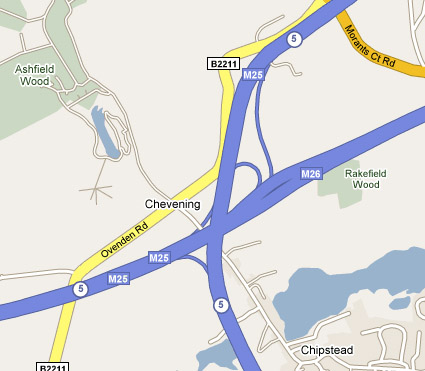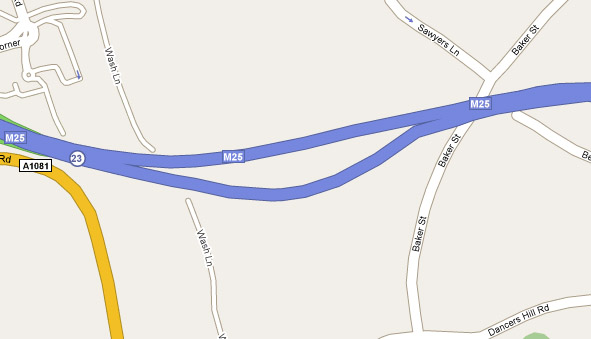M25 Lap - difference in distance clockwise vs anticlockwise.
Discussion
Personally I'd go with the answer of someone who has done some data logging measurements of it and not someone who has sat at their calculators. your stated assumptions make a hell of a lot of difference... what about Reigate hill and around he A1 where the motorways diverge and around heathrow were you've looking at 8 lanes each way... easily take your 0.07 or 0.07 to the actual 0.5!!
pembo said:
it's not a complete circle though, there are right and left turns in both directions so basing your calculations on it being a perfect circle would surely give a wrong answer
Not true actually. Intuition tells you that the 'wiggly' bits cancel out, and it's correct.The way to think about it is to take a single section of road which is a constant radius corner and apply the same logic to it. You'll be looking at a segment of a circle, say 10%. The circumference will be 2*pi*radius of corner*10%. The difference will still be 2*pi*width of road.
This argument can be proven to be correct for constant curve sections of any length, even down to the infinitesimally smally. So lets imagine you divide the whole M25 into tiny sections, some right hand some left hand bends. On the right handers the difference will be +2*pi*road width on the left handers it will be -2*pi*road width. You can cancel out almost all of these small sections with another until all that's left is a perfect circle.
I think I could write a mathematical proof for that, but I think explaining it would work better.
Edited by mrmr96 on Thursday 14th May 17:10
mrmr96 said:
I see your edit now says 0.07 miles where previously you'd written about 0.4 hadn't you?
On my first attempt (before) you replied with the answer I used only 2 lanes plus the dividing "lane" to calculate the difference and was out by one decimal place on transcribing from the calculator, so my first attempt was 0.05 of a mile.I then adjusted for 2 lanes plus 3 lanes plus the dividing barrier to give me the 18m difference and transcribed properly to get 0.07 miles.
I then went back and tidied up langauge and grammar.
mrmr96 said:
youngysr, you're nearly there but if you use more algebra you get a better answer (IMO).
r(a) = radius anti clockwise
r(c) = radius clockwise
c(a) = circumference anti clockwise
c(c) = circumference clockwise
c(a) = 2 * pi * r(a)
c(c) = 2 * pi * r(c)
A standard lane is 3.6m wide. So, assuming 3 lanes each way, plus 3.6m for the central reservation means there are 6 x 3.6m between the middle of lane one on each carriageway. Which is 21.6 meters.
So r(c)=r(a)+21.6
So:
c(c)-c(a)= (2 * pi * r(c)) - (2 * pi * r(a))
= 2 * pi * (r(c)-r(a))
= 2 * pi * (r(a)+21.6-r(a))
= 2 * pi * 21.6
= 135.7 meters
= 0.08 miles
(pi is approx 3.14159265 btw)
I don't know who is sadder :r(a) = radius anti clockwise
r(c) = radius clockwise
c(a) = circumference anti clockwise
c(c) = circumference clockwise
c(a) = 2 * pi * r(a)
c(c) = 2 * pi * r(c)
A standard lane is 3.6m wide. So, assuming 3 lanes each way, plus 3.6m for the central reservation means there are 6 x 3.6m between the middle of lane one on each carriageway. Which is 21.6 meters.
So r(c)=r(a)+21.6
So:
c(c)-c(a)= (2 * pi * r(c)) - (2 * pi * r(a))
= 2 * pi * (r(c)-r(a))
= 2 * pi * (r(a)+21.6-r(a))
= 2 * pi * 21.6
= 135.7 meters
= 0.08 miles
(pi is approx 3.14159265 btw)
Edited by mrmr96 on Thursday 14th May 16:52
you for calculating that and writing it down.
or me, for reading it and nodding silently to myself

I'm too lazy to work it out.
Someone mad on the internet said:
The M25 isn't continuous, but the 117 or 118 miles (estimates vary) includes the shortish length of A road.
The carriageways are 36 feet, and the central reservation is around 15 feet. Therefore the lateral distance between the centre-lines of Lane 1 on each side is 75 feet. If the M25 were a perfect circle, the difference would be 471 feet. If it were a perfect square, the difference would be 600 feet. It is, of course, neither of these things, but it gives us some idea of what the difference is likely to be, remembering that there will be some sections where the curve reverses and the difference goes in the opposite direction (junctions 15 to 16, and at junctions 9 and 23 for example). I would guess that the actual difference is most likely to be about 540 feet.
As in all threads of this sort, it is wonderful to see how the theme wanders into unrelated areas - even how you spell "pi".
Peter Hewitt
http://www.ukmotorwayarchive.org/
The carriageways are 36 feet, and the central reservation is around 15 feet. Therefore the lateral distance between the centre-lines of Lane 1 on each side is 75 feet. If the M25 were a perfect circle, the difference would be 471 feet. If it were a perfect square, the difference would be 600 feet. It is, of course, neither of these things, but it gives us some idea of what the difference is likely to be, remembering that there will be some sections where the curve reverses and the difference goes in the opposite direction (junctions 15 to 16, and at junctions 9 and 23 for example). I would guess that the actual difference is most likely to be about 540 feet.
As in all threads of this sort, it is wonderful to see how the theme wanders into unrelated areas - even how you spell "pi".
Peter Hewitt
http://www.ukmotorwayarchive.org/
Marcellus said:
Personally I'd go with the answer of someone who has done some data logging measurements of it and not someone who has sat at their calculators. your stated assumptions make a hell of a lot of difference... what about Reigate hill and around he A1 where the motorways diverge and around heathrow were you've looking at 8 lanes each way... easily take your 0.07 or 0.07 to the actual 0.5!!
The big assumption is lane width, I'd have thought this would average more like 4 lanes given that a lot of the M25 is now at least 4 lanes and very little of it is less than 3 lanes. In parts arond Heathrow it gets up to 6 lanes on the clockwise carriageway alone I believe, but at least two of them are a filter to turn off.Marcellus said:
so are you maintaining that your mathematical solution is the correct one versus Podie who actually measured it every day for a prolonged period??
Nope. Measuring it for real will be more accurate because of the variations ignored by the mathematical model.Orangecurry said:
I'm too lazy to work it out.
Cheers, that's interesting. 471ft is about 143meters so near to my answer.Someone mad on the internet said:
The M25 isn't continuous, but the 117 or 118 miles (estimates vary) includes the shortish length of A road.
The carriageways are 36 feet, and the central reservation is around 15 feet. Therefore the lateral distance between the centre-lines of Lane 1 on each side is 75 feet. If the M25 were a perfect circle, the difference would be 471 feet. If it were a perfect square, the difference would be 600 feet. It is, of course, neither of these things, but it gives us some idea of what the difference is likely to be, remembering that there will be some sections where the curve reverses and the difference goes in the opposite direction (junctions 15 to 16, and at junctions 9 and 23 for example). I would guess that the actual difference is most likely to be about 540 feet.
As in all threads of this sort, it is wonderful to see how the theme wanders into unrelated areas - even how you spell "pi".
Peter Hewitt
http://www.ukmotorwayarchive.org/
The carriageways are 36 feet, and the central reservation is around 15 feet. Therefore the lateral distance between the centre-lines of Lane 1 on each side is 75 feet. If the M25 were a perfect circle, the difference would be 471 feet. If it were a perfect square, the difference would be 600 feet. It is, of course, neither of these things, but it gives us some idea of what the difference is likely to be, remembering that there will be some sections where the curve reverses and the difference goes in the opposite direction (junctions 15 to 16, and at junctions 9 and 23 for example). I would guess that the actual difference is most likely to be about 540 feet.
As in all threads of this sort, it is wonderful to see how the theme wanders into unrelated areas - even how you spell "pi".
Peter Hewitt
http://www.ukmotorwayarchive.org/
Gassing Station | General Gassing | Top of Page | What's New | My Stuff








